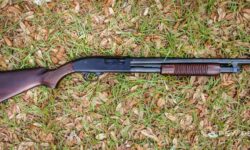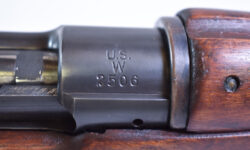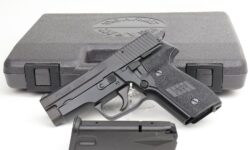How to Sight in a Rifle Scope?
Owning a gun is awesome, owning a rifle is even better, but I think that one of the best things is sniping targets within long distances with your rifle equipped with a good scope. And while shooting long-range targets might be one of the best feelings ever, it’s certainly frustrating to fire your rifle and miss your shot just because of an unsighted scope. So today, we’re taking a look at everything about sighting and making sure your rifle scope is performing at its best.
How to Sight in a Rifle Scope: Focus it!
The very first thing to consider before sighting your rifle scope is to make sure that your scope is focused. To do that, you need to focus two things on your scope, the reticle or crosshair, and the field of view or your target.
The first thing you have to focus is the reticle, to do this I need you to make sure your firearm has its safety on since the first thing we need to do is point your scope to a plain background like the sky or a wall without too much detail. Now I’m assuming that you know the parts on your scope so the next thing to do is to manipulate your diopter which is commonly a ring near the eyepiece, or sometimes it’s the eyepiece itself. When you twist the diopter in both directions, check the reticle if it improves. The trick to making sure that you get the right focus is to only look at the reticle for a maximum of 3 seconds otherwise your eyes will automatically focus for you. Once you get your reticle nice and clear, lock your diopter.
The next thing to do is to focus the field of view which is easier to do. It just involves turning the knob commonly on the center-left side of your scope until you got it focused properly.
Now, check for one last thing, parallax. Parallax happens when the reticle and field of view are not simultaneously in focus. To do this, look down your scope around 4-5 inches away from the eyepiece and move your head around to see if the reticle is moving away from its target. If it does, refocus both the reticle and the field of view, and you should be fine.
Sighting in Your Scope
Now let’s get to sighting or zeroing your scope. There are several ways to do this, but before starting, I need you to make sure that you use a good gun rest so your rifle doesn’t move too much to get the best results. If you don’t have a good rest you can do with a bipod and a stock rest, or perhaps even two vises. And also print out a target with a bullseye and grid to sight faster and more accurately.
Two-Shot System
As the name says, the two-shot system allows you to sight your scope in as little as two shots. To do this, you must have your rifle fairly fixed with rests to allow less movement and have your bullseye as far as you can take it. And make sure that your scope is mounted securely. Assuming that you have everything ready, let’s get on with it.
- Prepare your rifle by having at least two rounds on the magazine, or on your side if you have a bolt action.
- Look through your scope and point it at the bullseye.
- Fire your first round by squeezing the trigger firmly to avoid any unnecessary movements.
- If your gun moved due to recoil, point the reticle to the bullseye again.
- Locate where your first shot landed.
- Without moving your rifle and while still pointing at the bullseye. Make small adjustments until your reticle now points to your first shot.
- Once your reticle is now pointing to your first shot. Point it again to the bullseye and take another shot.
- If your second shot lands on where your reticle is pointed, then your scope is now sighted.
- Repeat steps 2-7 if necessary.
Now obviously, this is not exactly the most accurate way to sight your scope. But, the more accurate way just involves firing more shots between each adjustment. But it’s still essentially the same steps.
Boresighting
Firing several shots might not be the best thing sometimes. If you’re hunting, you can scare off your prey while sighting, or perhaps, you don’t want to waste bullets, or pay for the gun range, or perhaps you want a sighting method that’s easy, cheap, and quieter to do. Bore sighting allows you to do just that. While the two-shot sighting method requires you to see where the bullet went, in this method, you’ll look straight down the barrel and see where a bullet would go. Now there are still two ways to bore sight, and without any more chatter, here are the different ways:
Bore Sighting with a Naked Eye
Bore sighting with your naked eye is the cheapest way to do it. You don’t have to pay for extra ammunition, gun range fees, or even extra fancy equipment. Although the setback here is that you won’t be able to fully sight your scope with pinpoint accuracy, and you will only be able to do this on bolt action rifles. Given that there would be no extra preparations, let’s get straight to it.
- Put ANY small target as far as you can. There’s no need for a printed target with a bullseye, as long you have a good reference point, it’ll do.
- The first thing to do with your rifle is to take your bolt off to provide unrestricted access to your barrel.
- Take a look down the barrel and point it to your target.
- Without moving the rifle, look down at your scope
- Make the necessary adjustments to make sure you’re seeing the same thing between your scope and barrel.
- And it’s just that easy!
Boresight with Lasers
Okay, okay, I hear you, maybe your eyes aren’t that great, and bore sighting with a naked eye is not very accurate even with perfect eyesight. And if you don’t want to take your bolt off your rifle, or if you don’t even have a bolt action rifle, then there’s still the next option for you; LASERS! And let me tell you, you won’t take off any part of your gun, you’ll sight in faster, and you don’t even need to use a gun rest.
Now there are two types of bore sighting lasers you can get, there are muzzle lasers and there are bullet-shaped lasers. The only thing to consider is compatibility. Muzzle-mounted laser sighters commonly include a kit of attachments to ensure proper bore fitment, so at least make sure that you know your rifle’s bore size and check it with the laser you’re buying to make sure. On the other hand, bullet lasers are sized as proper bullets so get the same cartridge-sized laser.
Here’s how to use them both:
- Attach your muzzle laser on your muzzle, or load your bullet laser. Ensure proper fitment to get the best results, and make sure it’s already powered on.
- While the laser is on, take a look at your scope, and locate the laser point.
- Adjust until the laser and your reticle are aligned.
- It’s that quick and easy!
Conclusion
Some people think that sighting can be a tedious task. To them, I say do the bore sighting methods. And take the proper two-shot method if you’re feeling skeptical with bore sighting. Whatever method you choose, you have fun doing it, and observe gun safety at all times. Happy shooting!
[sc name=”faq2questions” q1=”Sighting in your scope” a1=”There are several ways to do this, but before starting, I …” q2=”Two-shot system ” a2=”To do this, you must have your rifle fairly fixed with rests to allow …” ][/sc]


